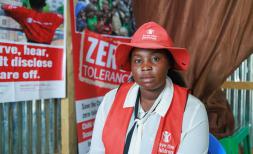What does the future look like for the children who remain in Afghanistan?

As harrowing footage emerges of children being passed over airport walls by parents in a desperate attempt to flee, many are asking me the same question: What does the future look like for the children who remain in Afghanistan?
It’s a question that has been at the forefront of our minds since Save the Children started working in Afghanistan in 1976 – and one to which the answer now looks painfully uncertain. Last year we reached over 1.6 million Afghans, but now all our operations have been suspended.
Like other NGOs, we are committed to staying and delivering our life-saving work and will resume our activities soon as it is safe to do so. We have no intention of abandoning the staff, children and communities we have worked with for over four decades. So, our message to the UN, governments and other humanitarian agencies is clear: now is not the time to shirk your obligations to the Afghan people.
Since the end of May alone, the number of people internally displaced by conflict and in need of aid has more than doubled, more than half a million Afghans have been displaced within Afghanistan – over 330,000 of them are children. These families are living outside in the open under tarpaulins, with no access to food or medical care. While many desperately try and get to the airport, shots can be heard overhead.
With food prices rising and the banking system on the verge of collapse, the situation is fast becoming even more dire. We spoke to families who survive on nothing but bread and energy drinks – the only food they can afford.
We have an absolute obligation to ensure their protection, their rights – and their survival.
But for aid efforts to continue in Afghanistan, funding needs to be provided urgently and humanitarian access for actors like Save the Children needs to be supported by both the global community, including donors like the US, and by the current authorities on the ground.
Safe passage to deliver lifesaving services in Afghanistan must be ensured for our brave female and male front line workers who, even amidst the chaos, tell us they want to go back to serving their communities, as doctors, nurses and teachers, among many other vital roles.
Ordinary Afghan people did not cause this crisis. Yet, while we’re unable to get aid to the most vulnerable, their lives hang in the balance.
Even before the recent escalation, almost half of the population - including nearly 10 million children - were in need of humanitarian assistance. Our staff have witnessed children succumbing to malnutrition, seen the devastation wreaked on communities by the drought, the impact on young girls when they have been subject to early marriage and then violation of children’s rights, when they are forced into work.
At the same time, we witness the extraordinary impact that education has on children, the difference it can make to give a child’s mental health when they are given a safe space to play– how those interventions bolster their knowledge and their self-confidence.
Our commitment to Afghanistan isn’t just to the children and families who rely on our and other organisation’s life-saving services, inside or outside the country. It also lies with our staff who we are dedicated to supporting in whatever way we can. For those that want to leave, while we welcome moves by a number of countries to open up immigration routes, the process for granting visa applications must be simplified and urgently expedited so that those who do wish to leave are able to do so.
Let this be a loud cry for Afghan children and their families who need support, wherever they are. Going hungry or wanting to go to school in Afghanistan, or in limbo in a crushing asylum system – there is not a single one of us that does not owe them our attention, support and protection.
We cannot abandon Afghanistan, and let us be clear that that obligation transcends borders; protect and provide aid to those Afghans still in Afghanistan and welcome and support those Afghans who have fled.
Now is the time to act to give Afghan children the future they deserve; one where their bellies are full, their minds and bodies are strong, and above all, where they are free and safe.







